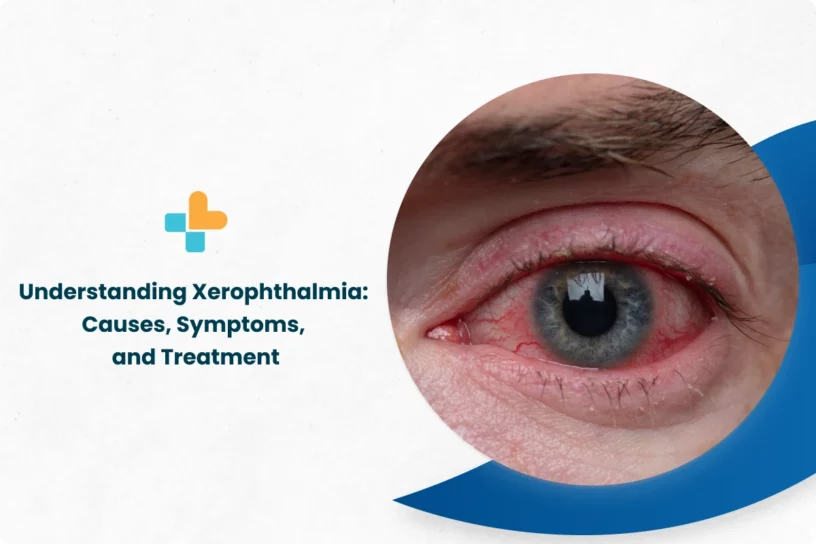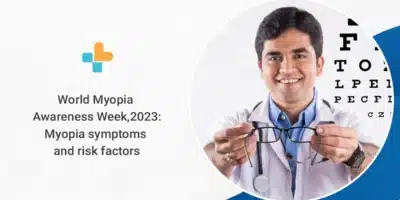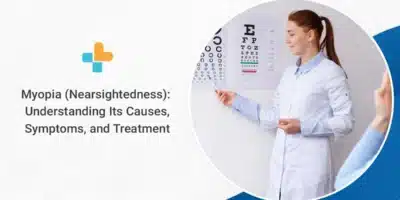Remember when your mom insisted on eating carrots? Well, those are the storehouses of vitamin A. This vitamin contributes a lot to good eye health, hence its deficiency leads to problems such as xerophthalmia. In this blog, the question “what is xerophthalmia” shall be answered in detail, along with the treatment options available.
What is xerophthalmia?
As mentioned earlier, xerophthalmia is a condition where the eyes go dry, due to a deficiency of vitamin A. When left untreated, It might develop into eye spots or night blindness. Eventually, blindness may result if the eye’s cornea is damaged. The condition is more commonly observed in developing countries, where access to proper diet might be restricted.
What causes xerophthalmia?
Vitamin A is not produced in the human body. Thus, consuming vitamin-rich food items or taking supplements is the only way to go. Vitamin A plays a huge role in vision, by aiding in the synthesis of rhodopsin, a vital photopigment for vision. A deficiency of this vitamin hinders the formation of this pigment, thus acting as a xerophthalmia cause.
Besides, a condition called xerophthalmia develops, where the eyes dry up because the conjunctiva’s glands are no longer operating regularly and tears and mucus are lost.
Symptoms of xerophthalmia
Some of the most common xerophthalmia symptoms are:
- Night blindness: The ability to adapt from a well-lighted environment to a poorly-lighted one, is lost. Hence the person cannot see in dark, or dimly lighted places.
- Development of spots: Soon tiny triangular spots form on the white portion of the eye, accompanied by drying of the cornea.
- Keratomalacia: As the condition progresses, the cornea gets soft and cloudy. Blindness follows if left untreated.
Who’s at risk for xerophthalmia?
Xerophthalmia has the following risk factors:
- Young age: The occurrence of vitamin A deficiency is more common amongst children or infants.
- Poverty: Diseases like xerophthalmia are more prone to occur in people who are hungry or live in poverty.
- Diarrhoea: Those who have frequent diarrhoea are more likely to develop xerophthalmia owing to the rapid depletion of vitamin A.
- Other diseases: The presence of diseases such as liver cirrhosis, cystic fibrosis, etc. increases the likelihood of developing xerophthalmia.
How much vitamin A do you need?
Depending on age and gender, vitamin A requirements vary. Below mentioned numbers given by NIH will give a clear idea:
- Children up to the age of 14: 400-600 mcg (Both male and female).
- Above 14 years: 900 mcg (males) and 700 mcg (females).
Where is vitamin A found?
Vitamin A is found in a variety of sources, both animal-based and plant-based. Here’s a list:
- Dairy products such as yoghurt, milk, and cheese.
- Meat, poultry, liver products.
- Oily fish.
- Colourful vegetables, such as carrots, red peppers, spinach, etc.
- Fruits such as apricots, mangoes, papaya, etc.
Diagnosis of xerophthalmia
Upon visiting the doctor, he will examine you physically and inquire about your problems and nutrition. Blood tests will be conducted to measure vitamin A levels in the bloodstream. The doctor may start treatment if the situation is severe.
How is xerophthalmia treated?
Supplementing with vitamin A is the primary xerophthalmia treatment. It is possible to inject or consume vitamin A orally. Age and general health conditions of the patient affect the dosage.
You could be given medicines to stop subsequent infections in more severe situations when the cornea has been injured. Until the lesion heals, you may be required to maintain your eye bandaged to safeguard it.
The doctor also suggests changes in the diet i.e inclusion of foods such as fruits and vegetables rich in beta carotene. Often eye drops are prescribed to manage the dryness of the cornea.
What can you expect?
When vitamin A pills are used, xerophthalmia swiftly gets better. Scarring may still be present in very advanced instances and impede vision. In the worst scenarios, blindness may become permanent. With quick treatment, the symptoms will resolve within a couple of months.
How can xerophthalmia be prevented?
Including vitamin-A-rich food items in your diet will help to prevent xerophthalmia. Some examples include oranges, papaya, broccoli, sweet potatoes, etc. Most importantly, health education and awareness are necessary for regions where people are unaware of the xerophthalmia disease and its consequences.
Conclusion
To sum up, xerophthalmia is treatable, especially when detected early. One should not take this lightly, since permanent blindness may occur if left untreated. Still looking for an answer to “what is xerophthalmia?”At Ayu Health, an experienced team of doctors is present for support. Are you looking to book an appointment? Reach out at 636-610-0800.
Our Hospital Locations
Ophthalmology Surgery Hospitals in Chandigarh | Ophthalmology Surgery Hospitals in Bangalore | Ophthalmology Surgery Hospitals in Jaipur | Ophthalmology Surgery Hospitals in NCR | Ophthalmology Surgery Hospitals in Hyderabad
Our Doctors
Ophthalmology Surgery Doctors in Chandigarh | Ophthalmology Surgery Doctors in Bangalore | Ophthalmology Surgery Doctors in Jaipur | Ophthalmology Surgery Doctors in NCR | Ophthalmology Surgery Doctors in Hyderabad




